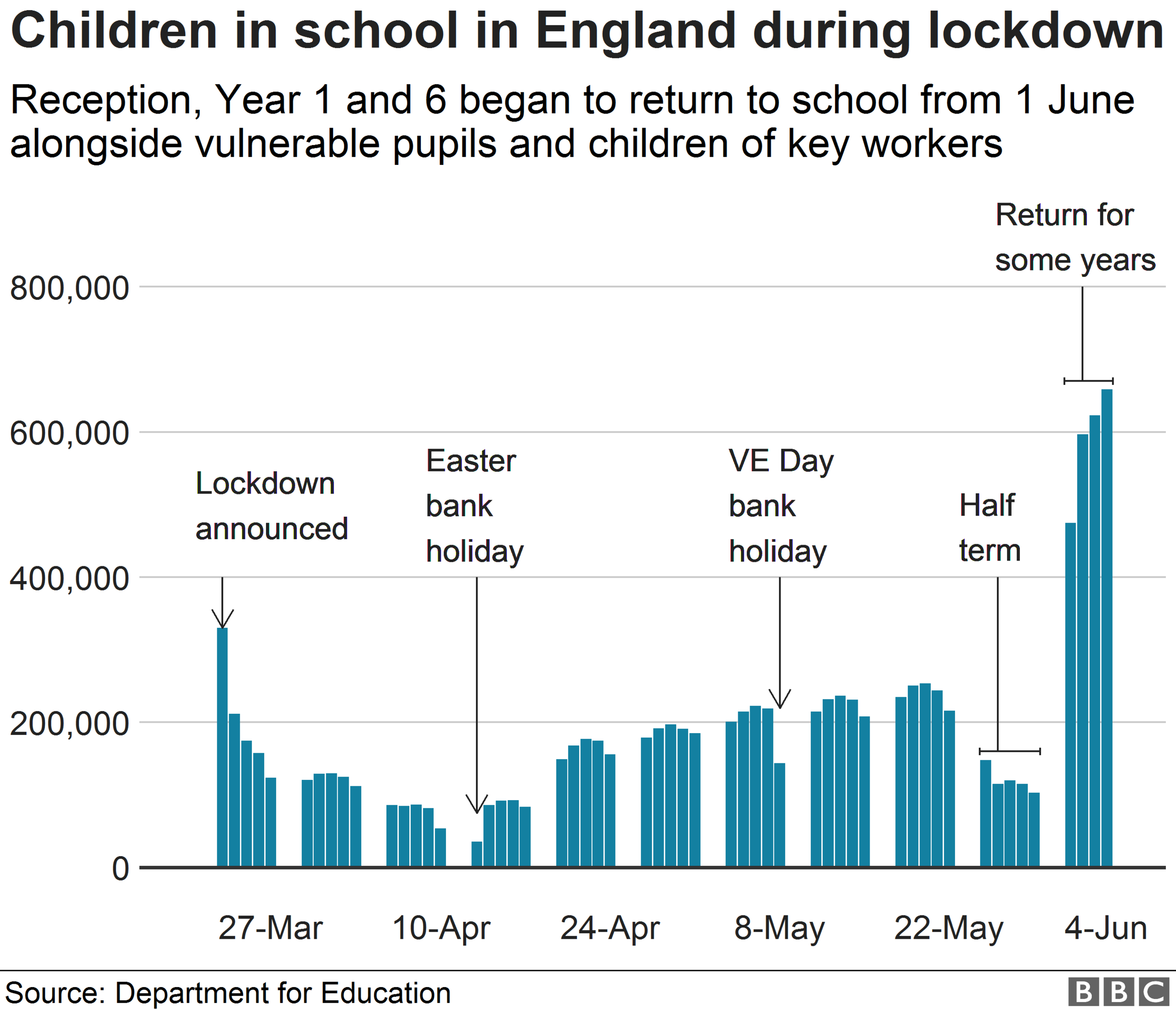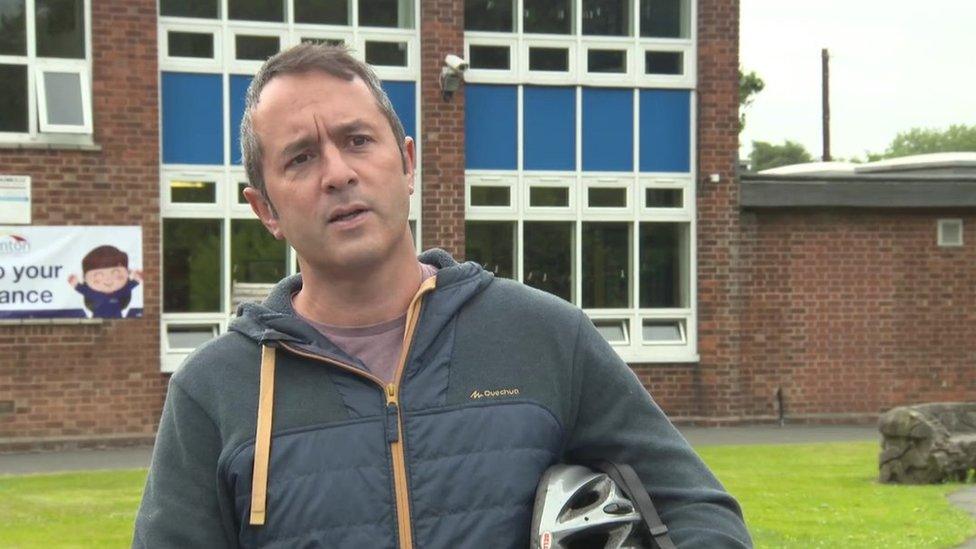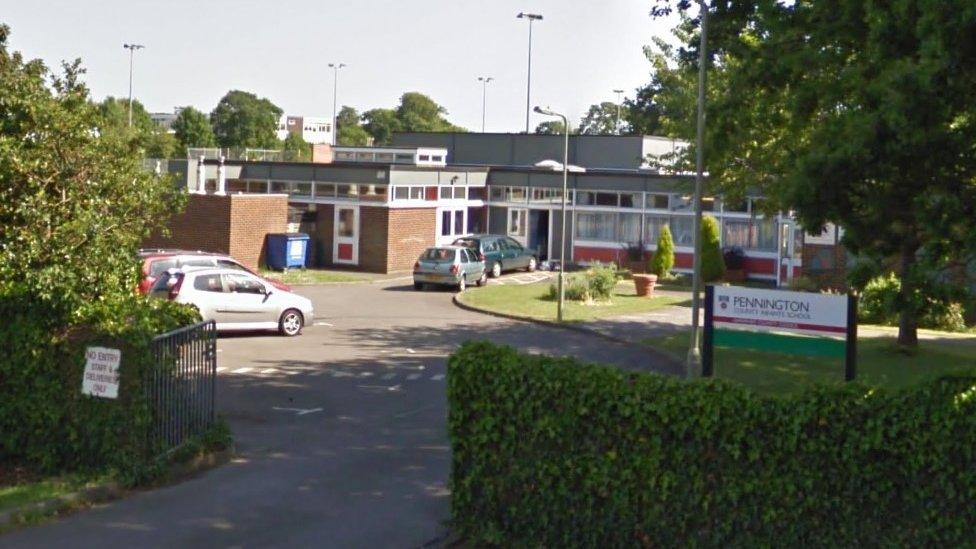Coronavirus: All primary pupils no longer going back to school
- Published
- comments

Plans for all England's primary children to return for a month before the summer break have been dropped by Education Secretary Gavin Williamson.
Confirming the move, he told MPs he wanted all children back to school in September and that "exams will take place next year".
Labour's Rebecca Long-Bailey expressed "deep dismay" at how the plans for bringing back pupils had been handled.
Head teachers' leaders said the plan had never been a practical possibility.
The education secretary told the House of Commons that there was a "cautious, phased return" to school - but that would no longer mean all primary year groups going back before the end of term.
Mr Williamson said that if schools had the capacity they could take more pupils if they chose.
Gavin Williamson says he is "working to bring all children back to school in September" across England
A-levels and GCSEs were cancelled this year by the pandemic - but he indicated that exams would go ahead in 2021.
The Department for Education issued figures showing about half of primary schools opened for extra pupils last week - and Mr Williamson told MPs that had risen to 70% this week.
But the Shadow Education Secretary Rebecca Long-Bailey said the plan for bringing back all primary pupils had never been possible with social distancing - and she accused Mr Williamson of failing to listen to the advice of the teaching profession.
"For weeks, head teachers, education unions, school staff and many parents have warned that the plans to open whole primary schools before the summer were simply impractical," she said.
The Labour education spokeswoman warned the government was failing to take action to help children catch up with missed lessons.
"I believe a crisis in education and children's attainment and well-being could come at us incredibly quickly if we do not step in and mitigate it now," Ms Long-Bailey told MPs.

About a quarter of primary pupils took up places
Primary pupils in England in Reception, Year 1 and 6 began to return to school last week - and the Department for Education has published the first official figures showing how many attended, based on 4 June.
This was in addition to the children of key workers and vulnerable children who have been able to keep going to school through the lockdown.
The figures on take-up show that about three quarters of those who could have returned to school were still at home - reflecting that almost half of schools were not open for extra pupils.
52% of primary schools opened for extra pupils
11% of primary pupils were in school - about a quarter of those year groups who could have gone back
659,000 children were in all schools, including children of key workers, almost 7% who would normally attend, up from 2.6% before half term


Head teachers had warned several weeks ago that it was not a realistic possibility to accommodate all primary year groups at the same time, with social distancing limiting their capacity.
Class sizes are now only 15 pupils or less - so if each class occupied two classrooms, school leaders argued that they would have no space for all year groups to return.
"The 'ambition' to bring back all primary year groups for a month before the end of the summer term was a case of the government over-promising something that wasn't deliverable," said Geoff Barton, leader of the ASCL head teachers' union.
"It isn't possible to do that while maintaining small class sizes and social bubbles," he said.


However the practicalities can be explained away - and it is true that the government always said the return was an ambition, not a firm plan - the retreat from the full return looks messy and gives the impression to millions of families that Downing Street didn't deliver what they promised.
There is a reluctant sense in government that they were damned if they set out a timetable that they then failed to keep to, and damned if they continued to leave the nation's diaries blank for months.
Remember, for several weeks opposition politicians were calling for Number 10 to give their exit strategy as quickly as they could.
When it was published, the documents and the speeches were full of "ifs" and "buts".
But there is a curious sense of impotence about all of this.
Read more from Laura here

The announcement means that many primary school children, outside of Reception, Years 1 and 6, will not be back in school until September.
Apart from some lessons for Years 10 and 12 from 15 June, secondary schools will also not return until September - and the Children's Commissioner for England, Anne Longfield, said the prospect was "deeply worrying".
Some students returned to school at the beginning of the month
"It's a disruption we've not seen since the Second World War," she said, warning that "the education divide is broadening" and "almost a decade of catching up on that education gap may well be lost".
Robert Halfon, chair of the education select committee, called for a national strategic plan to get schools open as soon as possible. He also warned that with schools remaining closed the majority of pupils would lose 40% of their time in class this year.

Parents' views are mixed
Jonathan Wills a parent from Barnton Primary in Northwich in Cheshire says families need to get back to some sort of routine - and that it was long way off for schools not to go back until the autumn.

Jonathan Wills says many families are struggling
"I think it's going to be extremely difficult for kids and some families, because it's a long time to try to recreate the structure that schools give you.
"I think the kids that were struggling before will be struggling even more now."
But mother-of-one Molly told the BBC she is relieved that not all primary years will be returning this term, as she would not have been prepared to send her daughter back to school.
"Until it is safe for Parliament to sit next to each other and until it's 'safe' to cuddle your own blood mother, then how is it deemed safe to mix your children with numerous other households?
"But our children can be placed into school with numerous other households' children. Even at small groups of 15, how is that safe? When we are only allowed to meet up in groups of six?"

"I think we're a strange country in which we turn a blind eye to mass demonstrations all over in every city, we campaign for pubs and cafes to open and yet we say to open schools before September is too risky," said Mr Halfon.
Schools in Wales will reopen from 29 June to all age groups for limited periods during the week, while Scottish schools are to reopen at the start of the autumn term on 11 August, with some continued home-learning.
Some Northern Irish pupils preparing for exams and those about to move to post-primary schools will go back in late August, with a phased return for the rest in September.The UK has recorded its lowest daily rise in the number of coronavirus deaths since before lockdown on 23 March, according to the latest government figures.

A SIMPLE GUIDE: How do I protect myself?
IMPACT: What the virus does to the body
RECOVERY: How long does it take?
LOCKDOWN: How can we lift restrictions?
ENDGAME: How do we get out of this mess?

A further 55 people died after testing positive with the virus as of 17:00 BST on Sunday, taking the total to 40,597.
There tends to be fewer deaths reported on Mondays - due to a reporting lag over the weekend.
The figures came as a study estimated lockdowns have saved more than three million lives from coronavirus in Europe.
Researchers from Imperial College London used computer models to predict the spread of the virus if no restrictions had been put in place in 11 European countries, finding that the "death toll would have been huge" without lockdown.

I MAY DESTROY YOU: The next must-see show in lockdown
TRAIN WRIGHT: Mark Wright's lockdown workout

In the UK, the lockdown prevented 470,000 deaths up to 4 May, according to the study.
According to the Office for National Statistics (ONS), less than a fifth of deaths registered in England and Wales during the last week of May involved Covid-19 - the lowest proportion since the lockdown began.
There were 9,824 deaths registered during that week - less than the previous week, but still 1,653 deaths higher than what would usually be expected, the ONS said. Of these, 1,822 involved the virus.
Can children catch and spread coronavirus?
- Published9 June 2020

- Published21 May 2020
- Published31 May 2020

- Published9 June 2020
